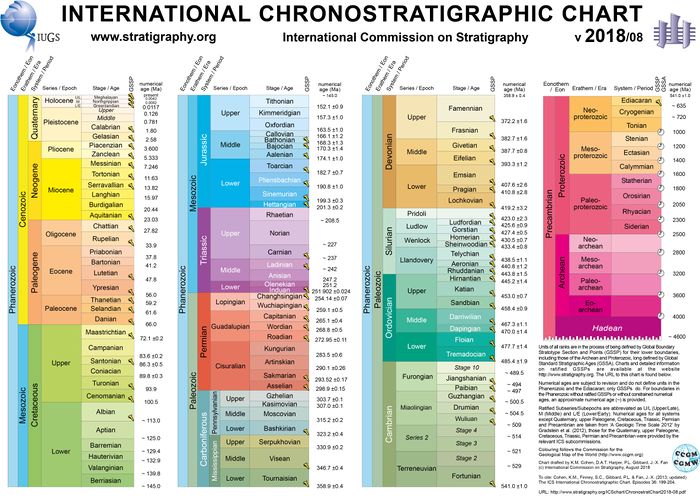Meghalayan
The Meghalayan is the current geological age that the Earth is in. It began approximately 4200 years ago (c.2250 BCE) with a major, global drought that affected many ancient civilizations (Figure 1).[1] The drought caused major cultural shifts in many of the ancients civilizations, including civilizations in Egypt, Mesopotamia, the Indus River valley, and the Yangtze River valley. It was officially ratified as an age by the International Commission on Stratigraphy in June of 2018. The Meghalayan is considered unique because it is the first unit of geologic time that begins with coinciding natural and cultural events. All previous units of geologic time were defined based solely on natural events.[2]
-
Figure 1. Quaternary period time scale. Note the Meghalayan, at the top right.[1]
-
Figure 2. Cross-section of the stalagmite from Meghalaya, India that was used to define the timeframe of the Meghalayan.[3]
Evidence of the drought (sometimes dubbed a "megadrought") can be found on all the continents. The Meghalayan is named after Meghalaya, India, where the stalagmite that has been used as the definitive marker to define the Meghalayan was discovered (Figure 2).[3] The Meghalayan age is a unit within the Holocene epoch. There is some debate as to whether the Holocene should be called the Anthropocene ("anthro" refers to humans and human influences), due to the major changes that people have caused to the Earth and its ecosystems. Typically only natural events are used to mark the beginning and end of geologic timescale units. Some people believe that humans now have a great enough influence on Earth's systems that that human-caused, or anthropogenic, events should be used as time scale markers as well.[4]

For Further Reading
References
- ↑ 1.0 1.1 1.2 International Commission on Stratigraphy."International Chronostratigraphic Chart v2018" Accessed Nov.8, 2018 [Online]. Available: http://www.stratigraphy.org/index.php/ics-chart-timescale
- ↑ Deanna Conners. Sept 2018."Welcome to the Meghalayan age" Accessed Dec.8, 2018 [Online]. Available: https://earthsky.org/earth/new-name-present-times-era-meghalayan
- ↑ 3.0 3.1 International Commission on Stratigraphy."Formal subdivision of the Holocene Series/Epoch" Accessed Dec.8, 2018 [Online]. Available:http://www.stratigraphy.org/index.php/ics-news-and-meetings/125-formal-subdivision-of-the-holocene-series-epoch
- ↑ Rull, Valentí. "The “Anthropocene”: neglects, misconceptions, and possible futures: The term “Anthropocene” is often erroneously used, as it is not formally defined yet." EMBO reports (2017): e201744231. Available from: https://onlinelibrary.wiley.com/doi/full/10.15252/embr.201744231


![Figure 1. Quaternary period time scale. Note the Meghalayan, at the top right.[1]](/wiki/images/thumb/6/68/Chronostratchart1.jpg/522px-Chronostratchart1.jpg)
![Figure 2. Cross-section of the stalagmite from Meghalaya, India that was used to define the timeframe of the Meghalayan.[3]](/wiki/images/thumb/e/e3/Meghalayan-stalagmite_530.jpg/319px-Meghalayan-stalagmite_530.jpg)